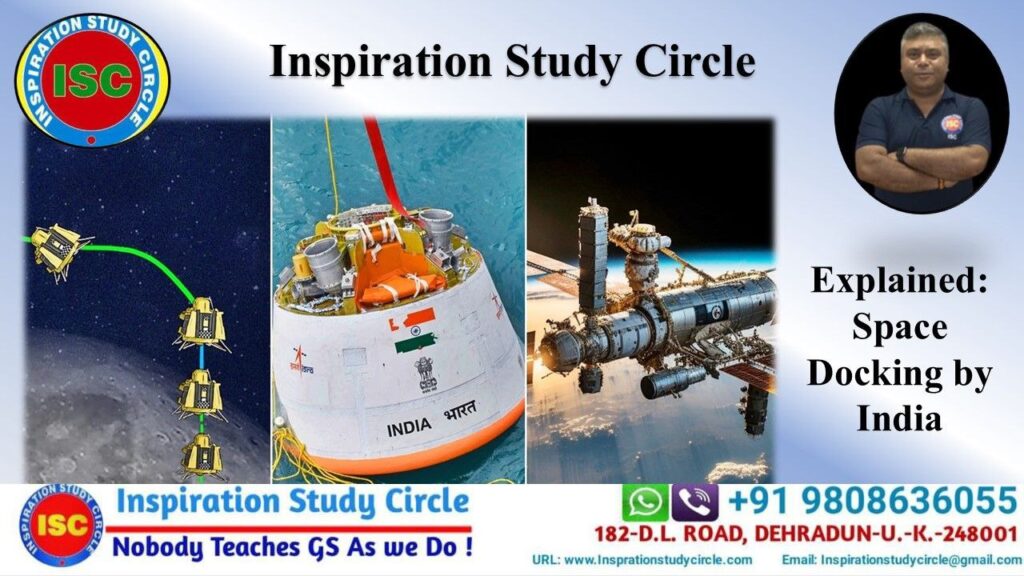
The Viksit Bharat – Guarantee for Rozgar and Ajeevika Mission (Gramin) Bill, 2025
The Viksit Bharat – Guarantee for Rozgar and Ajeevika Mission (Gramin) Bill, 2025 Table of Contents The Viksit Bharat – Guarantee
India has recently made significant strides in space docking technology, marking a historic achievement for its space program, which is a major milestone. India becomes 4th nation to dock satellites in orbit.
Here are the key points regarding space docking in India:

Space docking usually refers to the process of connecting two spacecraft together while in space. This can be done for various reasons, such as transferring crew or supplies between the spacecraft, combining resources, or creating a larger structure.
There are different methods for space docking, including:
Space docking is a critical capability for space missions involving multiple spacecraft, such as space stations or missions to other planets. It allows for increased flexibility and efficiency in space operations by enabling spacecraft to work together and share resources.
SpaDeX or Space Docking Experiment is a twin satellite mission developed by the Indian Space Research Organisation (ISRO) to mature and demonstrate technologies related to orbital rendezvous, docking, and formation flying, which will have future applications in areas such as human spaceflight, in-space satellite servicing, and other proximity operations.
SpaDeX consists of two modified IMS-1 class satellites weighing 220 kg each. During proximity operations, one spacecraft acts as a Chaser, and the other acts as a Target.
Both spacecraft were launched together[4][5] from the First Launch Pad of Satish Dhawan Space Centre aboard a dedicated Polar Satellite Launch Vehicle on 30 December 2024 at 16:30:15 UTC and subsequently injected into slightly different orbits.
After deployment, the two spacecraft then executed maneuvers to bring them together again. The Chaser (SDX01) approached the target (SDX02) and then carried out precision maneuvers to complete a successful docking. With this success, India became only the fourth country to achieve successful space docking —following the United States, Russia, and China.
According to ISRO, the SpaDeX mission had the following objectives:
The designations SDX01 and SDX02 are assigned to the “Chaser” and “Target” satellites, respectively, though both host docking devices capable of active or passive functions.
The launch vehicle deployed the spacecraft separately to create a separation between them of about 20km. After the spacecraft executed maneuvers to prevent them from drifting further apart and then to begin the rendezvous operation.
The Chaser then began to approach the Target, gradually lowering the separation between them to a distance of a few meters. After docking was completed, the mission planned to establish and demonstrate the transfer of electrical power between the spacecraft.
The Space Applications Centre developed a miniaturized high-resolution camera with photo and video capability that was carried aboard SDX01. SDX02 was equipped with a Multi-Spectral Payload (MMX) for vegetation and natural resource monitoring. To properly plan the Gaganyaan missions, SDX02 has a radiation detector that will collect data on radiation levels in space.
After separation, the two spacecraft will run their payloads for a period of two years.
The Bhartiya Docking System (BDS) was developed by ISRO based on the International Docking System Standard (IDSS) after unsuccessful attempts to import the docking technology from abroad.
For autonomous docking, the relative velocities of SDX01 and SDX02 were reduced to 0.036 km/h or 10 mm/s using retrorockets and a sensor suite. In contrast to the 24 motors used in IDSS, the BDS only uses two. The docking port on SpaDeX is 450 mm in diameter, whereas the docking port at the Gaganyaan and Bharatiya Antariksha Station will be 800 mm.
The dual-motor actuation design was designed to help ensure secure connections and accurate alignment at low speeds. The real-time alignment and navigation were supported by proximity sensors, laser rangefinders, and rendezvous cameras. During docking operations, an Inter-Satellite Communication Link (ISL) provided smooth data transmission, improving the system’s dependability and autonomy. As soon as the satellites were under 5 km apart, they were able to communicate via ISL to share orientation and location information.
Space docking is crucial for India’s space ambitions as it enables the assembly of complex structures like a space station, facilitates the transfer of materials and crew between spacecraft, and is a critical technology for future missions like lunar exploration, sample return missions, and sending Indian astronauts to space, effectively positioning India as a major player in the global space community; achieving this capability also allows India to offer satellite servicing and maintenance services to other nations.
Key points about the importance of space docking for India:
Docking is necessary for building a space station (Bharatiya Antariksh Station) where modules need to be joined together in orbit, enabling complex scientific research and longer-duration space missions.
Docking technology is vital for future lunar missions like Chandrayaan, allowing for the transfer of samples and equipment between spacecraft.
The ability to dock will be critical for future crewed missions like Gaganyaan, enabling the transfer of astronauts and supplies to a space station.
Docking technology allows for refueling and repairing satellites in orbit, extending their operational life.
Successfully mastering space docking demonstrates India’s advanced space capabilities and establishes it as a leader in the global space industry.
By developing this technology, India can potentially offer docking services to other countries, opening up new market opportunities.
Space docking is a critical prerequisite for upcoming space missions, such as lunar exploration and the operation of space stations. By successfully executing this mission, ISRO is laying the foundation for autonomous docking—a vital capability for future missions like Chandrayaan-4.
In summary, India’s successful space docking experiment not only showcases its growing capabilities in space technology but also lays the groundwork for future ambitious space missions.

The Viksit Bharat – Guarantee for Rozgar and Ajeevika Mission (Gramin) Bill, 2025 Table of Contents The Viksit Bharat – Guarantee

How to Prepare for UKPCS 2026 in Six Months Table of Contents ISC- How to Prepare for UKPCS 2026 in

UKPSC Upper and Lower PCS Combined Batch for 2026-2027 Table of Contents Unlocking Uttarakhand’s Civil Services: The Power of UKPCS

Explained: Russian President Vladimir Putin’s State Visit to India Table of Contents Russian President Vladimir Putin conducted a state visit

UPPSC Upper PCS 2025: Mains Test Series and Answer Writing Table of Contents Inspiration Study Circle- Dehradun The UPPSC PCS

The Sanchar Saathi App Table of Contents The Sanchar Saathi app is a security and user-protection platform developed by India’s Department of Telecommunications (DoT) to help users manage mobile connections, report fraud, and locate lost phones